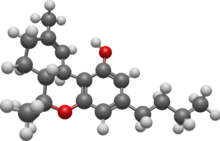 | |
 | |
| Clinical data | |
|---|---|
| ATC code |
|
| Identifiers | |
| |
| CAS Number | |
| PubChem CID | |
| ChemSpider | |
| UNII | |
| ChEMBL | |
| CompTox Dashboard (EPA) | |
| Chemical and physical data | |
| Formula | C20H28O2 |
| Molar mass | 300.442 g·mol−1 |
| 3D model (JSmol) | |
| |
| |
| | |
Δ9-Tetrahydrocannabutol (tetrahydrocannabinol-C4, THC-C4, Δ9-THCB, (C4)-Δ9-THC, butyl-THC) is a phytocannabinoid found in cannabis that is a homologue of tetrahydrocannabinol (THC), the main active component of Cannabis.[1] Structurally, they are only different by the pentyl side chain being replaced by a butyl side chain. THCB was studied by Roger Adams as early as 1942 [2]
- ^ Linciano P, Citti C, Luongo L, Belardo C, Maione S, Vandelli MA, et al. (January 2020). "Isolation of a High-Affinity Cannabinoid for the Human CB1 Receptor from a Medicinal Cannabis sativa Variety: Δ9-Tetrahydrocannabutol, the Butyl Homologue of Δ9-Tetrahydrocannabinol". Journal of Natural Products. 83 (1): 88–98. doi:10.1021/acs.jnatprod.9b00876. PMID 31891265. S2CID 209519659.
- ^ Adams R, Loewe S, Smith CM, McPhee WD (1942). "Tetrahydrocannabinol Homologs and Analogs with Marihuana Activity. XIII1". Journal of the American Chemical Society. 64 (3): 694–697. doi:10.1021/ja01255a061.
